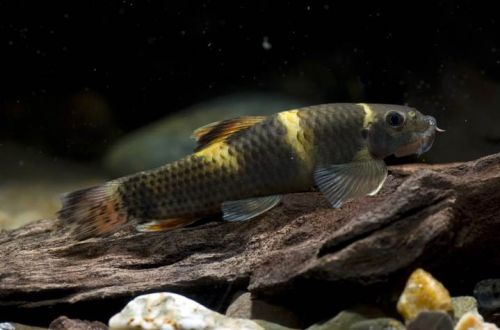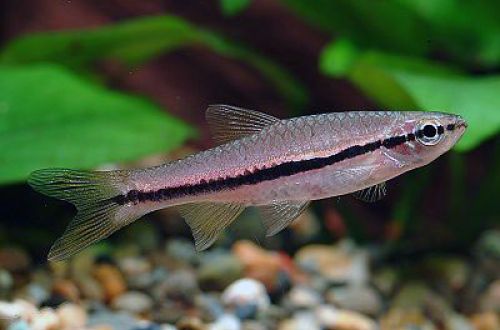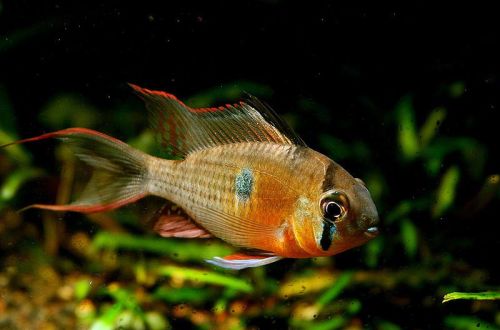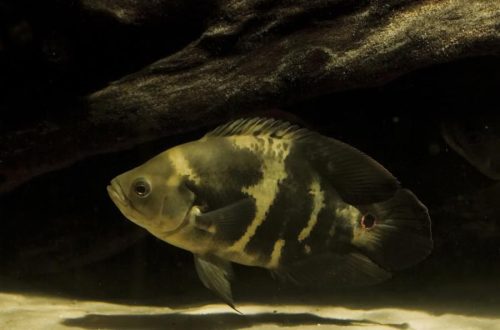
Garra rainbow
Garra rainbow or Garra Panda, scientific name Garra flavatra, belongs to the family Cyprinidae (Cyprinidae). It first appeared in the hobby aquarium hobby in 2005 and quickly gained popularity among hobbyists.

Contents
Habitat
It comes from Southeast Asia from the territory of modern Myanmar. Probably the natural habitat is limited to the state of Arakan on the west coast of the country. The fish inhabits numerous rivers flowing from the Rakhine mountain range and flowing into the Bay of Bengal.
A typical biotope is a shallow (about 30 cm deep) stream with clear clear water, substrata of stones and boulders. Aquatic vegetation is absent.
Brief information:
- The volume of the aquarium – from 80 liters.
- Temperature – 22-27°C
- Value pH — 6.5–7.5
- Water hardness – 2–12 dGH
- Substrate type — stony
- Lighting – bright
- Brackish water – no
- Water movement – moderate or strong
- The size of the fish is 7–9 cm.
- Nutrition – any food with a high content of plant components
- Temperament – conditionally peaceful
- Keeping in a group of 3-4 individuals
Description
Adult individuals reach a length of 7–9 cm. The color is dark with three rows of yellow vertical stripes ringing the body. The abdomen is light. The dorsal and caudal fins are red with black dots.
Sexual dimorphism is weakly expressed. Males look somewhat slimmer, and during the breeding season, small bumps appear on the head.
Food
In nature, it feeds on algae growing on the surface of stones. This diet has led to the misconception that the Garra Panda is a herbivorous species. You can read about this in many sources.
In fact, in addition to plant material, fish eat a lot of invertebrates that live among algae. Thus, the daily diet should include a varied diet. Dried sinking flakes, granules, tablets, pieces of green vegetables, and live or frozen foods (brine shrimp, bloodworms, daphnia, etc.) are good choices.
Maintenance and care, arrangement of the aquarium
The optimal size of the aquarium for a group of 3-4 fish starts from 80 liters. In the design, it is desirable to recreate an environment reminiscent of the rocky bottom of a mountain river. For example, large boulders, gravel, driftwood, unpretentious plants such as anubias, bolbitis, Javanese moss and others can become the basis of the decor.
Bright lighting will stimulate the growth of certain types of algae on the surface of stones and driftwood, which will become an additional source of food.
Fish that come from flowing reservoirs have increased requirements for water quality. Therefore, providing very clean, oxygen-rich water is of key importance when keeping Rainbow Garra. A productive filtration system and regular maintenance of the aquarium, in particular the removal of organic waste, will help with this.
The internal filter can become a source of internal current, which is welcome when keeping Garra Panda.
Behavior and Compatibility
They prefer to be in a group of 3-4 individuals. When kept alone, they become aggressive. Not too friendly to closely related species, as well as fish that live near the bottom, such as catfish. As neighbors in the aquarium, you should purchase fish of a comparable size that live in the water column or near the surface.
Breeding / breeding
In favorable conditions, breeding can be carried out in a common aquarium. The stimulus for spawning is enhanced feeding with high protein feed. Spawning occurs at dawn. The fish spawn near the ground. The incubation period lasts 24-30 hours. For another two days, the fry feed on the remains of their yolk sac and only then begin to search for food. Parental instincts are not developed. Adult fish tend to eat their own offspring.
Fish diseases
The cause of most diseases is a long stay in an unsuitable habitat and poor nutrition. If deviations are noticed in the appearance of the fish or in behavior, then first of all it is necessary to check the composition of the water for the presence of high concentrations of nitrogen cycle products, organic contaminants, etc. For more information about symptoms and methods of treatment, see the section “Diseases of aquarium fish”.





